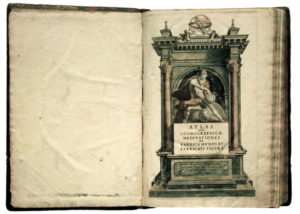During Dr. Kim Vaz-Deville’s lecture last month, and during the breakfast myself and my colleagues shared with her the morning after her talk, we spoke a lot about the Baby Dolls, including their origins, and addressed a lot of issues that center around racism and injustices that continue to happen today. One thing Dr. Vaz-Deville said that I found especially interesting is that the fleur-de-lis was a brand used to mark runaway slaves, a Louisiana symbol of Black Oppression. Upon learning this, I immediately made a connection to a few of the pieces of art I had seen in my Renaissance English course with Dr. Samuel Fallon on world-making.
For example, this map by Abraham Ortelius, where the fleur-de-lis symbol can be seen on both edges of the message at the bottom of the page:

In another example from an atlas by Gerhard Mercator, the fleur-de-lis symbol can be seen at the top of the structure on the left and right sides (unfortunately it is blurry).
I noticed these symbols at the time in my Renaissance English class, but I did not know their significance, so I stored the thought in the back of my mind until later when Dr. Vaz-Deville mentioned them in her lecture.
After conducting a bit of research, I now know that the fleur-de-lis symbol has a troubled past. When “the black code”, or “code noir”, was adopted by Louisiana in 1724 as well as other French territories around the world, it was “meant to govern the state’s slave population”, and the fleur-de-lis, a symbol of supremacy from the French Revolution, was used to brand runaway slaves. If an enslaved person ran away more than once, they would receive a worse punishment. To Dr. Ibrahima Seck, a self-identified African interviewed in the USA Today article (with a link above), the fleur-de-lis symbol now brings only sadness. However, Seck also agreed with history professor Terence Fitzmorris in that it has also come to be a symbol of unity for New Orleans. The people oppressed by this symbol have now reclaimed it.
One important question now is how do I make the connection between the images from my Renaissance World-making course and the new information I have learned about the fleur-de-lis? Well, a world can be seen as an individual person’s world, the broader, more all-encompassing world, somewhere in between, or something different altogether. In the individual sense, the fleur-de-lis affects a lot of people personally, whether in a bad sense when we think about some of its atrocious past, or in a hopeful sense, when we think about its new, reclaimed meaning. In the broader sense of the word, the fleur-de-lis is a symbol that stands for the unity of New Orleans, or perhaps the terrible past meaning, but this can vary from person to person, so we can see a bit of an intersection here.
When Dr. Vaz-Deville first started writing her book, she said it was difficult for people to open up and share their family stories. After all, black individuals have faced prejudice for so long, and the fleur-de-lis is still a popular symbol, stylized, referenced, and displayed often. In this discussion of worlds, we must be especially sensitive to what it means to each person individually. On this fleur-de-lis website, literally named after the symbol, nothing on this info page mentions its history in regards to New Orleans and slavery. It does, however, mention other meanings and interpretations, including its representation of the Virgin Mary and the Holy Trinity, symbols that carry positive meanings to some individuals.
To this point, Dr. Vaz-Deville reminded us that the idea of black pride is fairly recent. Black respectability politics came into a discussion of rights in regards to some of the groups participating in Mardi Gras. This discussion of judgement of expression made me think a lot about our reading on reclaiming feminism in Dr. Vaz-Deville’s book, because even though the Babydolls’ style stems from the vaudeville culture of the Batiste Family, who had Afro-Creole origins, it was judged and misinterpreted. Just as the Babydolls dressed in part to reclaim the meaning of feminism, some people have attempted to reclaim what the symbol of the fleur-de-lis is representative of, perhaps to change their own meaning of it. Overall, we must be conscientious of and sensitive to everyone’s interpretations, and thoughtful in our discussion of them.
